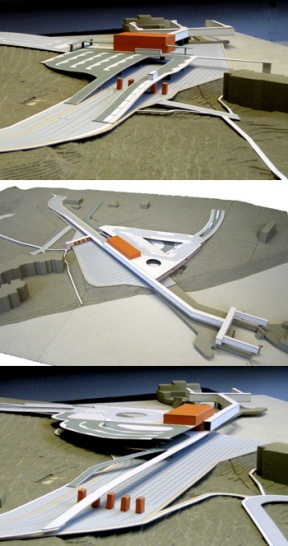Ferry terminal scoping continues, even as officials admit there’s not enough money.
A day after “rudder sputter” sidelined one of the ferry system’s biggest vessels, planner Rob Berman pointed to potential propulsion problems for the ferry terminal itself.
“All three of these are going to cost more money than the amount we have programmed,” Berman said Wednesday, referring to the latest designs for a new terminal on display at City Hall. “What we’re mainly trying to say is ‘okay, what’s the vision.’”
Berman’s statement came in response to questions about the project’s finances, which until recently have mostly remained in the background.
That changed after a ferry financing report ordered by the Legislature said the ferry system has an estimated $410 million in unfunded capital projects.
Then came the removal from the state’s budget of $40 million of the $160 million originally allocated for the new Bainbridge terminal.
The $40 million was to pay for a third slip, an element included in the 1998 terminal plans on which the current designs are based.
A later decision not to add a third vessel to the Seattle-Bainbridge route ended the need for a third slip, and led to the recent removal of the money from the project’s budget.
Despite funding concerns, planners said they will continue crafting a vision for the Winslow terminal, in need of new facilities and improved connectivity. The current building was constructed in 1950.
After months spent gathering input, ferry officials are finally ready for the next phase of planning.
The “scoping” period – during which project parameters, including those of the coming environmental review, are established – was to end Friday, but WSF extended it until Jan. 19. Planners will collate public and city input before beginning work on the environmental review that will stretch well into 2008.
Once scoping is finished, WSF will work with the city through a designated “point person” as they craft the environmental document, a draft of which will be presented at the end of this year when the preferred alternative is to be selected.
Construction is set to begin in 2009.
The latest plans reintroduce some elements that had seemingly been eliminated from consideration.
Two of the three designs include vehicle holding areas that accommodate 575 cars, a number WSF has stuck with firmly throughout the process. But one of the options now includes a smaller, 440-car holding area.
WSF spokesperson Joy Goldenberg said planners budged on the possibility of shrinking the holding area, which now holds 220 cars, because of criticism from the Bainbridge public and the city.
Consultants in charge of the recent financing study suggested that changing WSF’s fare structure in a way that would spread ridership throughout the day – instead of parking the ferries with commuter rushes in the morning and evening – might reduce the need to expand vehicle holding.
WSF has based the size of the holding area on ridership projections that were also criticized in the study.
Plans still call for a multi-level terminal, including a transit deck that will double bus capacity.
Planners also will look at creating a bus entrance at Ferncliff Avenue and another across from Cave Avenue.
Circulation and parking at the new “kiss ‘n ride” continue to be concerns, Berman said. He also said none of the three options preclude the possibility for future mass transit.
Planners will again study the feasibility of an underpass at the intersection of Winslow Way and state Route 305.
Many continue to argue in favor of such a plan, saying it would best separate 305 traffic from local traffic.
Planners had in recent months said at-grade solutions would be less expensive and less physically imposing than an underpass or bridge.
“Our objective is to look at a range of possibilities and then narrow our options as more information becomes available,” Goldenberg said. “The last thing we would want to say a year from now is ‘darn, we should have looked at that.’”
But some, like islander John Grinter, don’t feel WSF has been responsive to public concerns.
“I can say from firsthand experience at WSF’s ‘public’ meetings, that they are not willing to hear viewpoints contrary to their own desires,” Grinter wrote in a letter to the Review and local officials this week. “The structure of the meetings so far has not allowed for open public comment. Moderators are always on hand to curtail the comments of those who choose to speak extemporaneously and there is always a structure within which the discussion must remain.”
Grinter, who said he doesn’t often use the ferry, said parking and non-motorized access are among the many areas where community desires differ from those of WSF.
WSF has continually stressed the need to improve connectivity, by separating different modes of transportation, to meet its goal of loading passengers within 15 minutes of docking.
Planners say the key to that is creating wider thoroughfares for walk-ons, who should either load from both sides of the boat, or on one large ramp at the center of the deck above the bow, which would have to be extended to accommodate the new system.
Berman said the final design is still likely to be a combination of elements from the three plans. Priorities also must be established, since the project’s funding will require it to be built in stages.
“No, we’re not going to build it all tomorrow,” Berman said. “Yes, we do need your help to determine how we’re going to phase this.”



